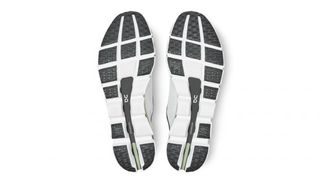Our Verdict
On’s first attempt at a long-distance carbon racing shoe is a swing and a miss. The Cloudboom has a harsh ride and none of the dynamism of rival super-shoes, while still being expensive.
For
- Good ground feel
Against
- Harsh ride
- No real benefit over a racing flat
- Many better options
You can trust Coach
After a few years when the Nike Vaporfly was the only real game in town, the world is now awash with running shoes containing carbon plates. Brands seem to have split into two camps when it comes to design.
The first is the Vaporfly camp, which is a shoe with a big chunk of soft, lightweight cushioning on the bottom along with the carbon plate. This cushioning protects the legs and makes for a bouncier ride but adds bulk, though the latest foams keep the shoes light.
Then there are low-profile designs that look more like racing flats, with just a touch more cushioning. These shoes provide a more traditional racing ride – hard and fast, with plenty of ground feel, plus the added propulsion of a carbon plate.
The On Cloudboom falls squarely into the latter category, alongside the Brooks Hyperion Elite and Asics Metaracer, though the latter is slightly softer underfoot. The Cloudboom is quick and has a slick, speedy look that many will prefer to the chunkier Vaporfly-style shoes, but that does come at a cost in terms of comfort.

On two shorter runs that hit 10-12km in total distance I enjoyed using the shoe, especially during a speed session where the carbon-infused plate plus the stripped-back design of the shoe proved ideal for 1km reps. However, on a 24km run the lack of protection underfoot started to tell. After the 17km mark each forefoot was starting to ache from the impact, and my legs felt like they’d been put through the wringer the next day.
The Cloudboom has been promoted by On as a long-distance racer, fit for the full marathon. However, brand representatives did suggest to us that it was more for 10K to half marathon, which is a little niche.
I couldn’t see myself taking on a full marathon in the Cloudboom, simply for fear that my legs would be in tatters by 30km. Cushioned carbon shoes like the Vaporfly, the new Nike Alphafly and Saucony’s Endorphin Pro all protect against this, leaving you more able to put in a strong finish to your long races.
The Cloudboom also suffers in comparison with the Asics Metaracer, which is lighter at 210g (UK size 9) against the Cloudboom’s 240g. The Metaracer feels faster to me, and also more comfortable, despite having a fairly thin stack of cushioning.
Part of the problem is On’s distinctive pod style of cushioning, which has always resulted in a fairly firm ride in my experience. Pairing that with a stiff carbon plate results in a shoe that’s only really for shorter races or people who prefer that very firm and responsive ride. Even in the latter case, I think the Metaracer is the better bet between the two if you’re lining up at a marathon.

The Cloudboom’s upper is a typical lightweight mesh job, breathable and comfortable around the toes. The design makes it fairly narrow and though I was able to go true to size without problems, going up a half size would probably work as well, especially if you do have wider feet.
There’s a welcome amount of rubber on the outsole for providing reliable grip even on wet roads, but although I found the shoe was fine on light trails and towpaths, you’ll probably want to avoid them purely because of how readily it picks up pebbles in the cracks between the pods.

Like all carbon-plate shoes, the Cloudboom has a hefty price. At £170 it’s a little cheaper than the Asics Metaracer at £180 and the Saucony Endorphin Pro at £190, and much cheaper than Nike’s shoes which cost £240 for the Vaporfly and £260 for the Alphafly.
Cost aside, either the Endorphin Pro or the Metaracer would be a better pick than the Cloudboom for most runners. The Saucony is certainly a preferable marathon running shoe, while the Metaracer might have a similar feel to the Cloudboom but it’s more cushioned, more comfortable and lighter.
While the Cloudboom is a fast shoe, it’s not quicker than other, more comfortable options; neither is it as light as shoes like the Alphafly or Endorphin Pro (both around 230g in a size 9). As a result it falls short of the carbon-plate podium, especially if you’re running 42.2km when the firm ride will hit your legs hard.

Nick Harris-Fry is a journalist who has been covering health and fitness since 2015. Nick is an avid runner, covering 70-110km a week, which gives him ample opportunity to test a wide range of running shoes and running gear. He is also the chief tester for fitness trackers and running watches, treadmills and exercise bikes, and workout headphones.

